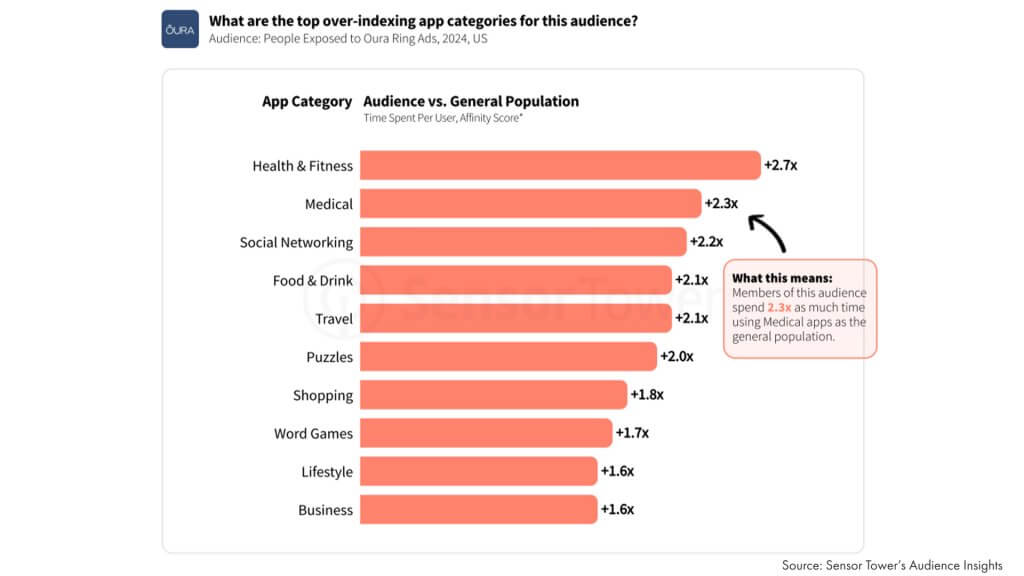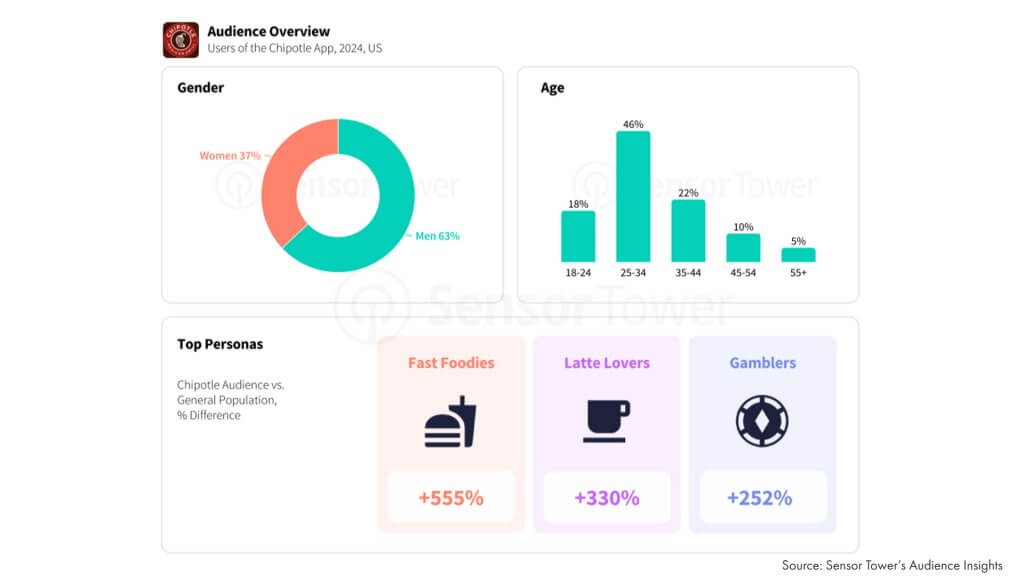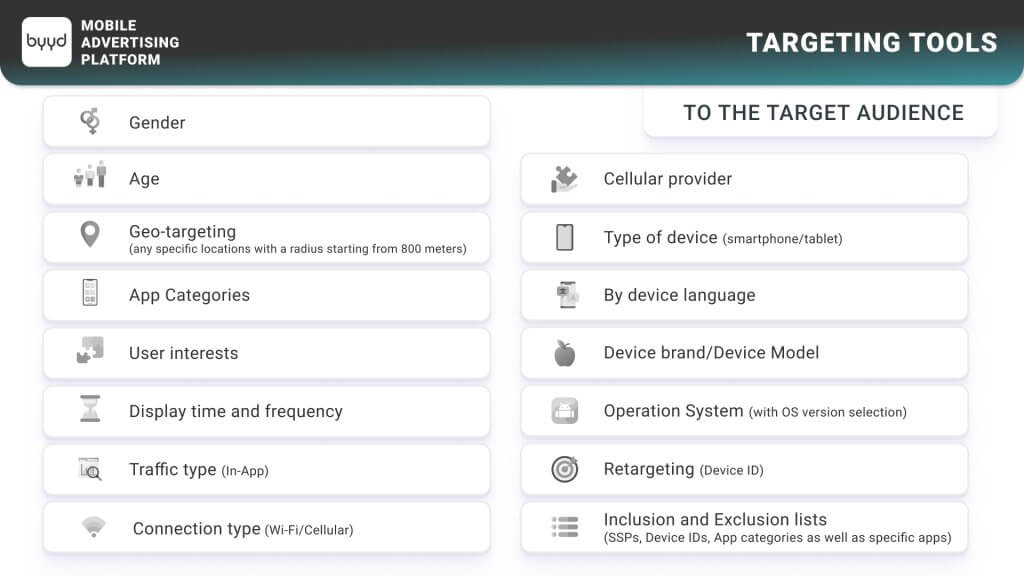From Data to Results: How Programmatic Connects Brands with Their Target Audience
To effectively build a marketing strategy, it is crucial to understand who your audience is, how they behave, and where they interact with content.
Imagine a young woman who starts her morning with a fitness app, orders coffee delivery at lunch, and spends her evening browsing Pinterest for home decor ideas. All of these are behavioral signals that help brands understand what the person is interested in and show ads that will resonate with her.
In this article, we explain how programmatic advertising uses audience data to reach relevant users and build personalized communication within the in-app ecosystem.
How the audience interacts with apps
Behavior within mobile apps reflects users’ lifestyles and priorities. For example, in 2024, the audience who saw ads for the Oura brand was 2.7 times more likely to visit Health & Fitness apps.
Understanding where the target audience spends the most time opens up new opportunities for communication and engagement with potential customers. This helps the brand go beyond obvious interaction scenarios.
An analysis of users who saw L’Oréal Paris ads in 2024, based on regional data from France, revealed that banners were displayed 2.8 times more frequently in the Latte Lovers category.
Interestingly, the two leading interest areas—Latte Lovers and Home Cooks—are not directly related to the beauty segment. These insights can serve as a starting point for new approaches to communicating with consumers and help the brand find an audience outside the traditional beauty category.
A cosmetics brand may find high engagement with beauty ads from users in lifestyle apps or on platforms focused on self-improvement. It could be in these spaces that the concept of self-care is formed, motivating real actions.
For example, for the promotion of the brand Mion, the BYYD team set up targeting based on relevant interests:
- Health & Fitness
- Dermatology
- Walking
- Yoga
- Shopping
How competitor strategy can be useful
Studying competitor strategies is not just a way to “snoop” on where they allocate their budget. It’s a tool to understand where your potential audience is and which channels perform best.
For example, if a competitor is heavily promoting in Health & Fitness or Food Delivery apps, it signals that those are spaces where users with similar interests to your target audience are concentrated.
Analyzing such data helps understand which app categories generate interest in a brand and which user segments remain untapped.
User interaction with the brand’s own app: what data it provides
Analyzing users who interact with a brand through its mobile app helps marketers better understand their profile and use this data to build their strategy.
For example, an analysis of Chipotle app users showed that 63% of the audience was male, with the highest concentration in the 25-34 age group.
The most engaged users were those interested in fast food, coffee, and gaming.
These insights allow the brand to better tailor marketing messages and personalize content, for example:
- Offer exclusive deals through the mobile app
- Use gaming mechanics and gamification to enhance loyalty
- Develop partnerships with brands that share similar audience interests
- Launch mobile ads based on available data
Segmentation in the in-app ecosystem: how to reach a relevant audience
The importance of segmentation
In the era of data personalization, accurate audience segmentation has become key to the effectiveness of any advertising campaign. In the in-app ecosystem, where users spend most of their mobile time, this allows brands to reach people who are genuinely interested in the product.
Segmentation helps avoid “media noise” and directs the advertising message to those most likely to engage—whether that means watching a video or visiting a website.
The role of app category
For example, a user actively engaging with psychology apps is more likely to respond to ads for self-development courses than someone using only utility apps or games.
Thus, choosing the right app categories not only increases CTR and engagement but also strengthens the associative link between the brand and its values.
BYYD and brand target audiences
The BYYD mobile platform uses device identifiers (IDFA/GAID) to form audience segments and optimize advertising campaigns.
Several parameters are considered:
- Social-demographic characteristics (gender, age, income, education)
- Interests and behaviors within apps
- Geolocation (BYYD also offers super-geo-targeting, which covers an audience within 800 meters of a given point)
- Device and operating system.
For more details on how Device ID is obtained and used in mobile advertising, read the article.
How BYYD solves data privacy issues
With the growing restrictions on cookies and enhanced privacy requirements, the advertising industry is shifting from browser cookie trackers to device identifiers (IDFA/GAID).
As a result, the importance of first-party data—the data provided directly by the user—and Device ID as the primary source of identification is growing.
When running ads through the BYYD platform, a setting is automatically applied to show the campaign only to users who have consented to activity tracking across apps and provided access to their Device ID.
How BYYD applies BIG DATA for targeting
With Big Data, mobile ads can be targeted to those segments that provide the greatest return. This reduces unnecessary expenses and improves ROI.
Big Data enhances:
- Social-demographic targeting. Data about gender, age, income, and marital status is used to display ads.
- Behavioral targeting. User actions are considered: what they searched for, which sites they visited, what products they viewed, and how they interacted with content.
- Contextual targeting based on device use. The system can consider which apps or at what times the user sees the ad.
- Look-alike targeting. Based on the characteristics of loyal users, Big Data finds users with similar parameters, etc.
For the promotion of DEONICA, BYYD used not only social-demographic parameters but also BIG DATA and set up ads for users who had already purchased deodorants. Data was based on receipts.
This approach helped reach nearly 900 thousand users and achieve a CTR of 2.04%.
How to understand your target audience and enhance advertising: tips
- Identify high-growth segments. Use behavioral data to discover untapped—and sometimes unexpected—user groups that could drive growth.
- Study competitor strategies. Compare your audience profile and media strategy with those of adjacent brands to identify overlaps, risks, and opportunities for improvement.
- Check targeting accuracy and improve communication. Analyze the audience by demographic parameters, app usage, and social media ad interactions.
- Use real behavioral data to create advertising messages. To truly connect with your audience, build creative and campaigns based on their interests and habits.
- Turn to mobile advertising to reach users where they spend most of their time—in mobile apps.
BYYD is a mobile DSP platform with more than 10 years of experience in in-app promotion. We help brands scale in local and international markets, providing precise targeting, transparent analytics, and innovative advertising solutions.
Check out the cases on the website and contact us to launch a campaign.
Was it useful? Then share it with friends and colleagues!
For consultation and cooperation:
- leave a request on the website;
- write to hello@byyd.me.







